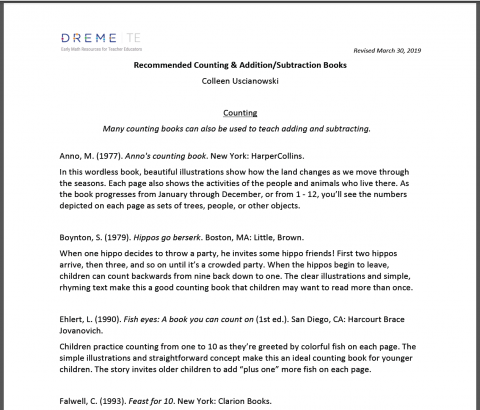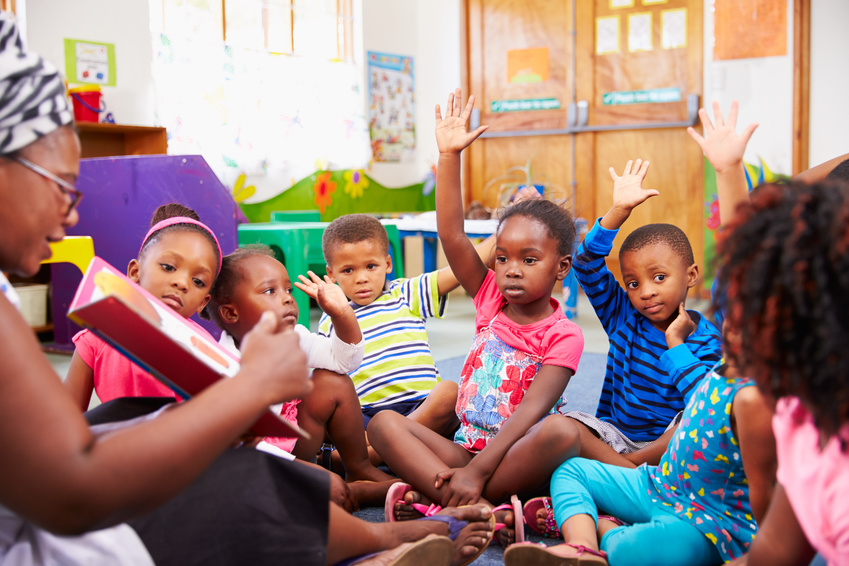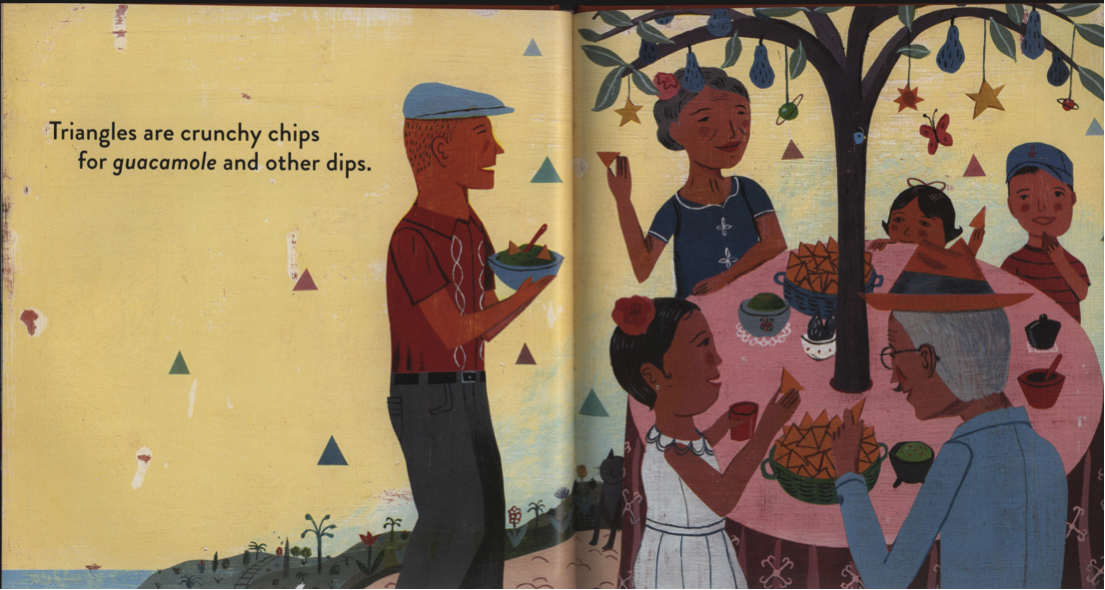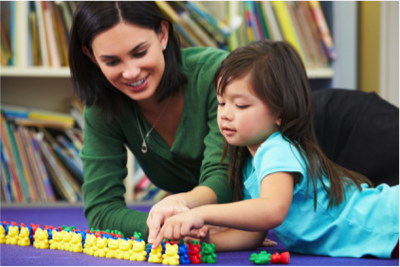Imagine that you, as a teacher, are preparing to read a book to a child or group of children and you want to use the story as an opportunity to develop understanding of counting. This document describes how you might proceed.
by Colleen Uscianowski, Colleen Oppenzato, & Herbert P. Ginsburg
Revised March 30, 2019
Recommended Counting Picture Books

Supporting Engagement with Counting Books
Preparing to Read
You can use Analyzing Picture Books—An Overview with its downloadable Math Picture Book Analysis Guide to help you examine and select one or more counting books. Review How to Use Picture Books for some general tips for how to plan to read books with children.
For example, you might choose Let’s Count by La Coccinella. Holes in this board book encourage the child to touch each animal while counting. For example, on this two-page spread, nine fish are shown.
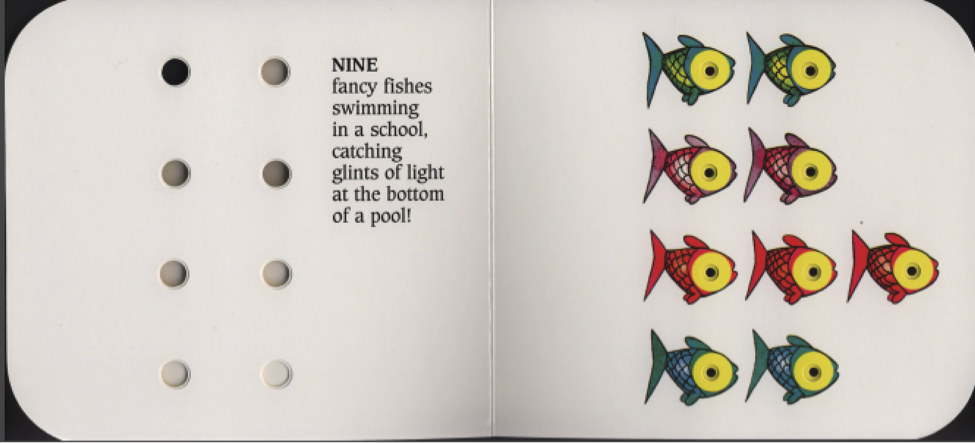
Look through the book from a child’s perspective. Think about what might help children understand the math on the page or what they might find confusing. For example, on the left-hand page above, in addition to the text describing the fish, you can see eight holes. These were the holes for the previous page, which showed eight mice. Children might be confused because this page is about the number nine, but they see eight holes on the left. The reader can anticipate their confusion and cover those eight holes with her hand or draw attention to the nine fish and nine holes on the right.
Look through the book from a mathematics perspective. The nine holes on the right-hand page can help children practice their number skills. Each hole shows the eye of one fish. Young children benefit from using their fingers to help them count carefully. The holes in the book provide tactile references to help children touch each fish and make sure they count each fish once and only once. The arrangement of the fish in rows and columns can also help children learn that numbers can be decomposed into smaller numbers, in this case, 9 is made up of 4 and 4 and 1 (looking at the columns), or 2, 2, 3 and 2 (looking at the rows). Or the groups of fish can be seen as 2, 2, 2, 2, and 1.
During Reading
Ask questions. As appropriate, ask a variety of question types, both lower-level and higher-level.
- Lower-level questions are relatively simple and concrete, addressing what children see directly on the page as well as key words from the text that you think they might not understand. For example:
- Recall: What animal did we see on the last page? How many were there?
- Label: What animal is this? How many do you see?
- Describe: How many red fish are there? How many blue fish? How many green fish? Can you tell me anything more about the fish?
- Higher-level questions are relatively complex and abstract, asking children to engage in deep thinking and go beyond the literal events on the page. For example:
- Predict: If we had 8 on the last page and 9 on this page, what number do you think we will see on the next page?
- Infer: If one fish swims away, how many fish will be left?
- Compare: Are there more blue fish or red fish? How do you know?
Explore children’s responses. Elaborate on children’s responses and ask follow-up questions. For example:
- Child: Fish! Fish! Fish!
- Teacher: That’s right, there’s fish! What do you see on the fish?
- Child: Fins! Up there and up there.
- Teacher: Oh, I see the fins. How many fins does each fish have?
Follow up with open-ended questions asking children to explain their reasoning. For example:
- Teacher: We have counted different numbers of animals on each page. We counted 7 chicks, 8 mice and now 9 fish. What do you think will happen on the next page?
- Child: I think there will be 10 animals.
- Teacher: Why do you think there will be 10 animals? What animal might be next?
Model complex thinking.
Children learn by listening to you, the adult, model productive ways of thinking about the story. For example:
- Teacher: I notice that the fish are lined up. Let’s see how many…There are 1, 2 green fish; 1, 2 purple fish; 1, 2 red fish; and 1, 2 blue fish. All of the fish are lined up in twos! I wonder if we could count them by twos...
More Examples for Counting Books
Some counting books, like Let’s Count, are fairly straightforward counting books. However, some counting books also contain narratives. Counting storybooks often have more realistic illustrations, which sometimes means the objects are not as easy to count as they are in straightforward counting books. We take our next example from Feast for 10 by Cathryn Falwell—a book about a family shopping for and preparing for a family feast. On this two-page spread, the children collect five kinds of beans and six bunches of greens. This is a different kind of book than Let’s Count because tactile cues are not given and the objects are not arranged in ways that are so easily countable.
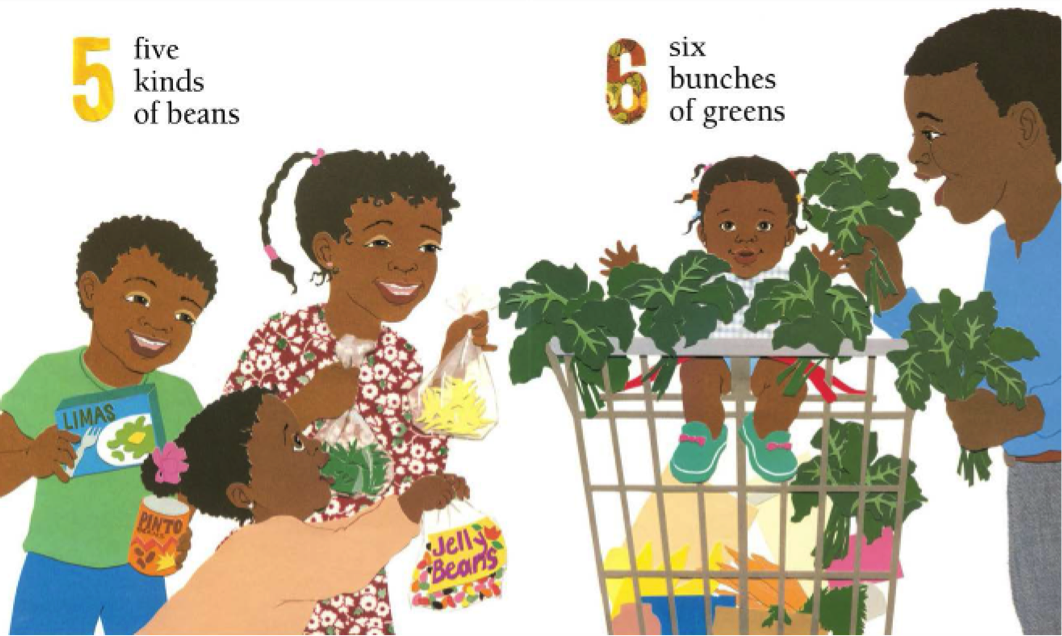
What Children Can Learn
Using Feast for 10, a teacher can focus on a variety of counting concepts.
To become proficient counters, children need to learn that we can count both individual objects and groups of objects. In real life, children could count each individual jelly bean or they could count the entire bag of jelly beans as “one bag.” To help children understand this counting concept, you can say:
- The beans are in bags, cans, and cartons. What are the different kinds of beans? What kind of container is used to hold each type of bean?
- Each bunch of greens has many leaves. How many bunches are there?
The arrangements of objects can vary. In Let’s Count, the objects are side by side, but in real life, objects can obscure one another or look alike. For example:
- There are 5 bunches of greens at the top of the cart. Where is the 6th bunch of greens?
- There is a bunch of leaves at the bottom of the cart. Is that another bunch of greens or something else?
Young children benefit from having a story to help them make sense of the counting concepts. Children may relate this book to their own experiences grocery shopping or cooking with their families. Young children can benefit from imagining themselves in the story and acting out similar scenarios. For example, after reading the story, teachers can use play food to engage children in dramatic play around shopping and cooking. Children can count the foods they buy or use them to make pretend meals.
Questioning the Child
Regardless of the objects being counted, you should ask both concrete and abstract questions.
Lower-level Questions
Ask children to describe the scene to find out how many math words and other words they use spontaneously.
- What’s happening on this page?
Ask children to name objects as you point them out.
- What is this? (while you point to the can of beans)
- What is the father holding in his hands?
Ask children to locate and count the six bunches of greens.
- I see six bunches of greens. Can you point to the bunches of greens and count them?
If the children struggle to correctly count the bunches of greens, you can provide guidance by counting along with them.
- Let’s try again. Count with me as I point to each bunch: one, two, three, four, five, and then at the bottom of the cart, six There are six bunches of greens!
Higher-level Questions
Ask children to predict how many foods the children will gather on the next page.
- They have 5 kinds of beans and 6 bunches of greens. What do you think will happen on the next page?
- What other foods do you think they might buy for the feast?
Ask children to compare the story to their own lives:
- Does your family like to eat beans, too? What other foods does your family like to eat?
- How many people are in your family? Is that more or less than the number of family members in the story?
Ask children to explain the character’s motivation.
- Why is the family buying so much food? What do you think they’ll do with all the groceries?
You can respond to children’s answers to any of these questions by asking,
- How do you know?
- Why?
- Can you explain what you said?

